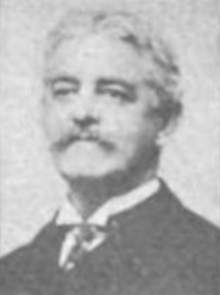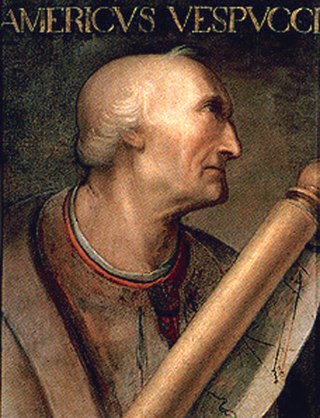
Amerigo Vespucci was an Italian merchant, explorer, and navigator from the Republic of Florence, from whose name the term "America" is derived.

Portuguese colonization of the Americas constituted territories in the Americas belonging to the Kingdom of Portugal. Portugal was the leading country in the European exploration of the world in the 15th century. The Treaty of Tordesillas in 1494 divided the Earth outside Europe into Castilian and Portuguese global territorial hemispheres for exclusive conquest and colonization. Portugal colonized parts of South America, but also made some unsuccessful attempts to colonize North America.
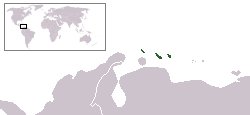
The ABC islands is the physical group of Aruba, Bonaire, and Curaçao, the three westernmost islands of the Leeward Antilles in the Caribbean Sea. These have a shared political history and a status of Dutch underlying ownership, since the Anglo-Dutch Treaty of 1814 ceded them back to the Netherlands, as Curaçao and Dependencies from 1815. They are a short distance north of the Falcón State, Venezuela. Aruba and Curaçao are autonomous, self governing constituent countries of the Kingdom of the Netherlands, while Bonaire is a special municipality of the Netherlands. Territories of the Kingdom of the Netherlands, the countries, and its special municipalities, are outside the European Union; citizens have Dutch nationality and the former colonial power benefits from preferential trade, mineral and natural resource rights, particularly offshore.

Charles Barney Cory was an American ornithologist and golfer.

A cacique was a tribal chieftain of the Taíno people, the indigenous inhabitants at European contact of the Bahamas, the Greater Antilles, and the northern Lesser Antilles. The term is a Spanish transliteration of the Taíno word kasike.

The Age of Discovery, also known as the early modern period, was a period largely overlapping with the Age of Sail, approximately from the 15th century to the 17th century in European history, during which seafaring Europeans explored, colonized, and conquered regions across the globe.

Alonso de Ojeda was a Spanish explorer, governor and conquistador. He travelled through modern-day Guyana, Venezuela, Trinidad, Tobago, Curaçao, Aruba and Colombia. He navigated with Amerigo Vespucci who is famous for having named Venezuela, which he explored during his first two expeditions, for having been the first European to visit Guyana, Curaçao, Colombia, and Lake Maracaibo, and later for founding Santa Cruz.

The Casa de Contratación or Casa de la Contratación de las Indias was established by the Crown of Castile, in 1503 in the port of Seville as a crown agency for the Spanish Empire. It functioned until 1790, when it was abolished in a government reorganization.

The yellow-rumped cacique is a passerine bird in the New World family Icteridae. It breeds in much of northern South America from Panama and Trinidad south to Peru, Bolivia and central Brazil. However, they have been sighted as far north as Nayarit state in Mexico.

The term New World is often used to mean the majority of Earth's Western Hemisphere, specifically the Americas. The term gained prominence in the early 16th century, during Europe's Age of Discovery, shortly after the Italian explorer Amerigo Vespucci concluded that America represented a new continent, and subsequently published his findings in a pamphlet he titled Latin: Mundus Novus. This realization expanded the geographical horizon of classical European geographers, who had thought the world consisted of Africa, Europe, and Asia, collectively now referred to as the Old World, or Afro-Eurasia. The Americas were thus also referred to as "the fourth part of the world".

The Americas, also known as America, are lands of the Western Hemisphere, composed of numerous entities and regions variably defined by geography, politics, and culture.
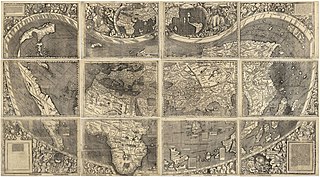
The Waldseemüller map or Universalis Cosmographia is a printed wall map of the world by German cartographer Martin Waldseemüller, originally published in April 1507. It is known as the first map to use the name "America". The name America is placed on South America on the main map. As explained in Cosmographiae Introductio, the name was bestowed in honor of the Italian Amerigo Vespucci.

The West Indies is a subregion of North America, surrounded by the North Atlantic Ocean and the Caribbean Sea, which comprises 13 independent island countries, 18 dependencies, and three archipelagos: the Greater Antilles, the Lesser Antilles, and the Lucayan Archipelago.

The Montserrat oriole is a medium-sized black-and-yellow icterid.

Quararibea turbinata, also known as the swizzlestick tree, is an aromatic plant native to such Caribbean locales as Antigua, Barbados, Dominica, Grenada, Guadeloupe, Hispaniola, Martinique, Montserrat, Netherlands Antilles, Puerto Rico, St. Kitts and Nevis, St. Lucia, Saint Vincent and the Grenadines and the Virgin Islands. It is generally described as a perennial tree or shrub and its common name comes from its use as a swizzle stick and its association with cocktails such as the Rum Swizzle.
The exploration of North America by European sailors and geographers was an effort by major European powers to map and explore the continent with the goal of economic, religious and military expansion. The combative and rapid nature of this exploration is the result of a series of countering actions by neighboring European nations to ensure no single country had garnered enough wealth and power from the Americas to militarily tip the scales over on the European continent. It spanned the late 15th to early 17th centuries, and consisted primarily of expeditions funded by Spain, England, France, and Portugal. See also the European colonization of the Americas.
The Province of Pánuco was a province of the Spanish colony of New Spain. It was probably discovered by Amerigo Vespucci in 1498, and later by Juan de Grijalva. It was located on the Mexican gulf coast centered on Santiestebán de Pánuco, from the river of Tuxpan and extending into the current state of Tamaulipas. Originally inhabited by Huastecs, it was claimed both by conquistador Hernán Cortés who sent Francisco de Montejo to claim the area and by Francisco de Garay, governor of Jamaica, who sent Alonso Alvarez de Pineda. The province was the object of a power struggle between supporters of Cortés and his opponents, first divided into encomiendas and allotted to Cortés supporters.
The Spanish and Taíno War of San Juan–Borikén, also known as the Taíno Rebellion of 1511, was the first major conflict to take place in modern-day Puerto Rico after the arrival of the Spaniards on November 19, 1493.
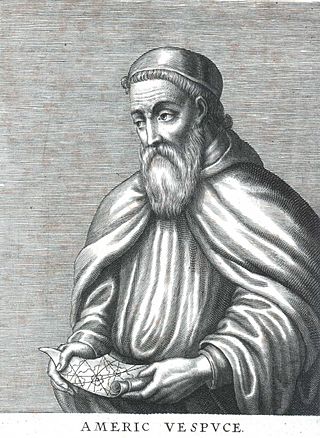
Amerigo Vespucci's Letter from Seville, written to his patron Lorenzo di Pierfrancesco de' Medici, describes experiences on Alonso de Ojeda's May 1499 voyage. Vespucci's findings during the Age of Discovery led Spain people to believe that North and South America were not connected to Asia, which was a common belief at the time and was even held by Vespucci himself. Despite the surrounding controversy among many historians about which Vespucci letters were real, and which ones were forged, this particular letter of Vespucci's is notable for its detailed description of the Brazilian coast and its inhabitants.
